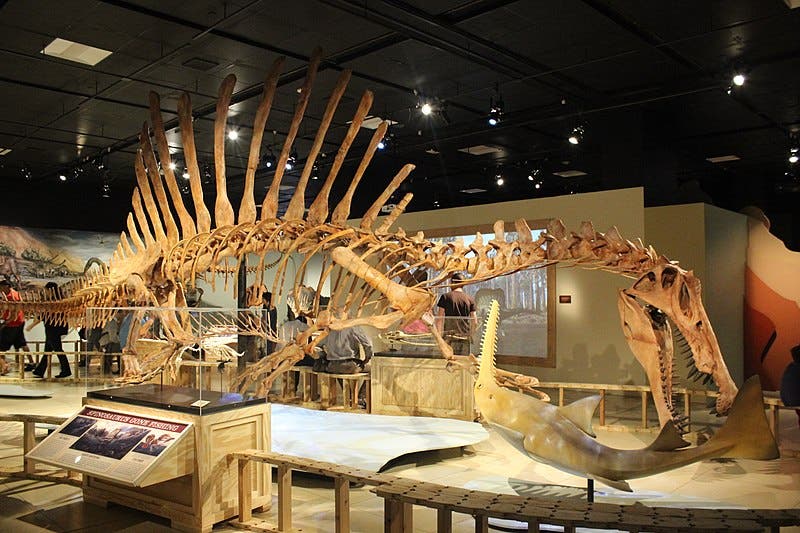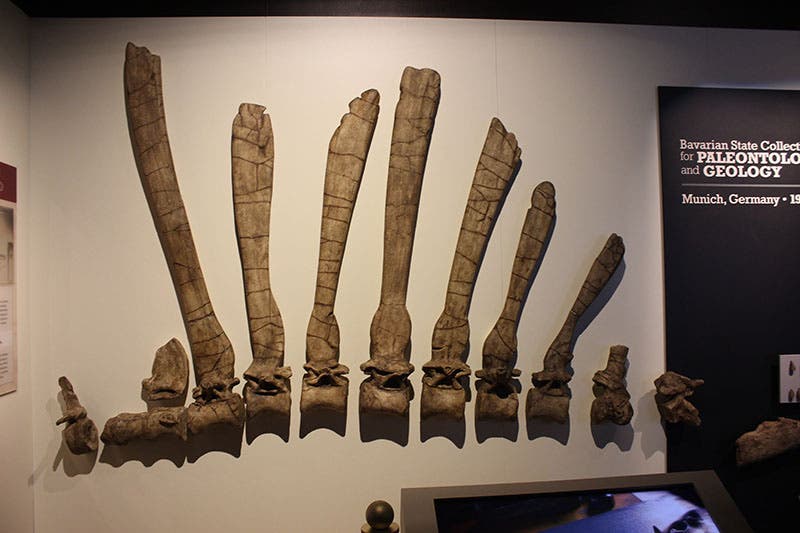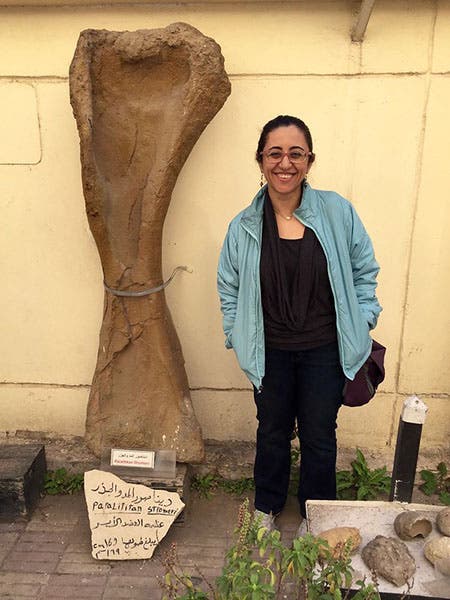Scientist of the Day - Ernst Stromer
Ernst Stromer, a German paleontologist, died Dec. 18, 1952, at the age of 81. In January of 1911, Stromer found the first dinosaur bones ever unearthed in Egypt. He was investigating the Bahariya oasis in the Western Desert, some 200 miles SW of Cairo, when the bones – 3 very large limb bones – came to light. Stromer had to return to Germany, but in 1912, Richard Markgraf, Stromer’s fossil collector, discovered a partial skeleton of an unknown dinosaur at the same site in Bahariya, which he shipped to Stromer, who by this time was back in Munich. The fossils consisted of a lower jaw, many teeth, and some vertebrae that had an odd feature – dorsal spines, up to a meter long, that stuck straight up, as if supporting a sail. Stromer reconstructed the dinosaur as best he could (there were no leg bones at all) and published a paper about the find in the Abhandlungen (Discourses) of the Bavarian Academy of Sciences. He called the new dinosaur Spinosaurus aegyptiacus, and he realized from the outset that this was one big theropod – almost fifty feet long, bigger even than the other therapod that had just been discovered in the American West, Tyrannosaurus rex.
In his initial paper, which we have in our serials collection, Stromer did not show a reconstruction, but he did present the fossil bones in two plates, one of which we show here (second image). In a paper published the previous year (1914), on the geology of Bahariya, Stromer had added a map with the Bahariya oasis colored in. I have never seen it reproduced anywhere, so we include a detail of it here. If you can find the hill labelled Gebel el Dist at top center, you have found the not-so-final resting place of Spinosaurus. I have also uploaded the complete map and some details of the Spinosaurus plates onto Flickr; you can find them in my photostream on Flickr, starting here.
Stromer’s reconstruction of a complete Spinosaurus only appeared 21 years later, in the same journal; we show it below (fourth image). The shaded bones are the ones recovered; everything else was conjectured.
By the time his Spinosaurus paper appeared, World War I was well underway, and Stromer was no longer welcome in Egypt. Markgraf had collected more bones but was unable to get permission to ship them to Stromer, and then Markgraf died, and so the bones sat in their crates in Cairo for 8 years. When Stromer did eventually manage to get them shipped in 1922, he found them broken to bits, having been unpacked, inspected, and then repacked several times. But he was able to slowly piece the fragments together, and by 1930, he began to publish a second series of papers, announcing three more new Egyptian dinosaurs: two carnivores, Bahariasaurus and Carcharodontosaurus, and a large herbivore, Aegyptosaurus. We have all those papers here in the Library.
Unfortuntately, this new spate of activity coincided with the rise of Hitler, and Stromer suffered, because he was outspoken in his opposition to Nazism. His career went rapidly downhill. Because he came from an aristocratic German family – his full name was Ernst Freiherr Stromer von Reichenbach – the Nazis avoided attacking him publicly or arresting him, but they made his life difficult. When he reached the age of 65 in 1937, he was forced to retire. When the war began, his three sons were conscripted and sent to the Russian front. Two of them were killed, in 1941 and 1944, and the third went missing, which much have devasted the aged Stromer.
But more tragedy was in store. His precious specimens from Egypt were on display in the Bavarian State Collection of Fossils in the Old Academy building in Munich, in danger from Allied bombing. He implored the museum director to move the entire fossil collection out of Munich and into safe hiding. But the director, a fervent Nazi, adhered to the party line that the Luftwaffe would protect Germans cities from attack, and refused to relocate the collection. On Apr. 25, 1944, Munich was attacked by hundreds of RAF bombers. The Academy building suffered a direct hit, and the entire Bavarian collection was destroyed, including all of Stromer's fossils. The Spinosaurus and Aegyptosaurus specimens were unique, the only ones in the world at the time, and they were now gone. Stromer had lost almost everything that had made his life meaningful – his sons, his fossils, his life's work. In 1951, his one surviving son returned from years in a Soviet labor camp. The hope that his missing son might still be alive may have been all that kept Stromer going. He died within a year of his son's return.
Stromer disappeared from dinosaur history as completely as his fossils, and he remained unknown and unsung for the next 40 years. Fortunately, his reputation is having a resurgence. Various dinosaur expeditions have returned to the Sahara and to Bahariya, and new specimens of Stromer's dinosurs have been recovered, including another Spinosaurus (found, however, in Morocco, not in Egypt), a reconstruction of which is on display in the National Geographic Museum in Washington, D.C (fifth image). The same museum has also attempted to reconstruct the display that Stromer had constructed in the museum in Munich (sixth image). Best of all, an expedition to Bahariya in 2000 yielded a new dinosaur, a gigantic sauropod. The expedition members, mostly from the University of Pennsylvania, had learned about Stromer and knew well the story of his destroyed fossils, and in a gesture of homage, they named their discovery Paralititan stromeri. The bones are on display in the Egyptian Geology Museum in Cairo. We link to a photo, supplied by Karl Galle, that shows a display of many of the bones laid out in cases – that is a photo of Stromer at the upper left, with one of the dinosaur bones he discovered in 1911, which we also show as our first image. A second photo by Karl shows a Paralititan humerus, alongside Karl’s wife Sylvia, and we show that one here as our seventh image, just below.
In 2014, Nova released a program, "Bigger than T-rex," all about Spinosaurus and Stromer; it includes a segment where a paleontologist visits the Stromer family castle outside Nuremberg and meets Stromer's granddaughter, who has lovingly kept all of Stromer’s papers and photos and the memorabilia that escaped the bombing. You can see the complete program here. We also recommend a book, The Lost Dinosaurs of Egypt (2002), by William Nothdurft and Josh Smith, an account of the 2000 expedition that recovered Paralititan, with frequent deep flashbacks to the tragic life and career of Ernst Stromer.
Dr. William B. Ashworth, Jr., Consultant for the History of Science, Linda Hall Library and Associate Professor emeritus, Department of History, University of Missouri-Kansas City. Comments or corrections are welcome; please direct to ashworthw@umkc.edu.












